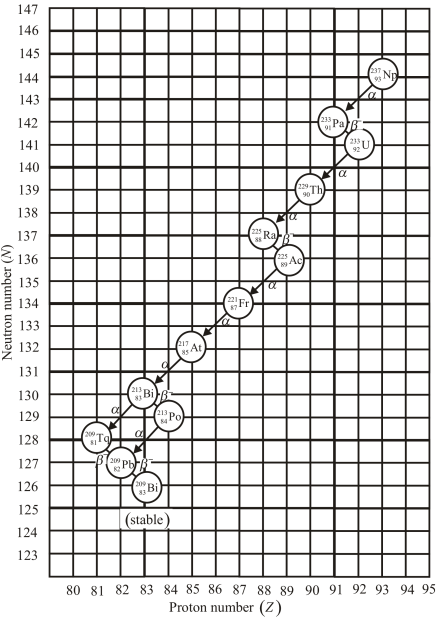
Concept explainers
(a)
The decay mode for each of the sequential decays.
(a)
Answer to Problem 10E

Explanation of Solution
Neptunium
Protactinium
Uranium
Thorium
Radium
Actinium
Francium
Astatine
Bismuth
Thallium
Lead

Conclusion:
Therefore, the decay mode for each of the sequential decays is,

(b)
The daughter nucleus at the end of each decay.
(b)
Answer to Problem 10E

Explanation of Solution
The daughter nucleus after alpha decay of Neptunium
The daughter nucleus after beta decay of Protactinium
The daughter nucleus after alpha decay of Uranium
The daughter nucleus after alpha decay of Thorium
The daughter nucleus after beta decay of Radium
The daughter nucleus after alpha decay of Actinium
The daughter nucleus after alpha decay of Francium
The daughter nucleus after alpha decay of Astatine
The daughter nucleus after alpha decay and beta decay of Bismuth
The daughter nucleus after beta decay of Thallium
The daughter nucleus after beta decay of Lead

Conclusion:
Therefore, the daughter nucleus at the end of each decay is,

Want to see more full solutions like this?
Chapter 10 Solutions
INTRO TO PHYSICAL SCIENCE W/MINDTAP
- Mick and Rick are twins born on Earth in the year 2175. Rick grows up to be an Earth-bound robotics technician while Mick becomes an intergalactic astronaut. Mick leaves the Earth on his first space mission in the year 2200 and travels, according to his clock, for 10 years at a speed of 0.75c. Unfortunately, at this point in his journey, the structure of his ship undergoes mechanical breakdown and the ship explodes. How old is Rick when his brother dies?arrow_forwardHi, I have canceled, why did you charge me again?arrow_forwardNo chatgpt pls will upvotearrow_forward
 Modern PhysicsPhysicsISBN:9781111794378Author:Raymond A. Serway, Clement J. Moses, Curt A. MoyerPublisher:Cengage Learning
Modern PhysicsPhysicsISBN:9781111794378Author:Raymond A. Serway, Clement J. Moses, Curt A. MoyerPublisher:Cengage Learning College PhysicsPhysicsISBN:9781938168000Author:Paul Peter Urone, Roger HinrichsPublisher:OpenStax College
College PhysicsPhysicsISBN:9781938168000Author:Paul Peter Urone, Roger HinrichsPublisher:OpenStax College University Physics Volume 3PhysicsISBN:9781938168185Author:William Moebs, Jeff SannyPublisher:OpenStax
University Physics Volume 3PhysicsISBN:9781938168185Author:William Moebs, Jeff SannyPublisher:OpenStax Principles of Physics: A Calculus-Based TextPhysicsISBN:9781133104261Author:Raymond A. Serway, John W. JewettPublisher:Cengage Learning
Principles of Physics: A Calculus-Based TextPhysicsISBN:9781133104261Author:Raymond A. Serway, John W. JewettPublisher:Cengage Learning Physics for Scientists and Engineers with Modern ...PhysicsISBN:9781337553292Author:Raymond A. Serway, John W. JewettPublisher:Cengage Learning
Physics for Scientists and Engineers with Modern ...PhysicsISBN:9781337553292Author:Raymond A. Serway, John W. JewettPublisher:Cengage Learning Glencoe Physics: Principles and Problems, Student...PhysicsISBN:9780078807213Author:Paul W. ZitzewitzPublisher:Glencoe/McGraw-Hill
Glencoe Physics: Principles and Problems, Student...PhysicsISBN:9780078807213Author:Paul W. ZitzewitzPublisher:Glencoe/McGraw-Hill





